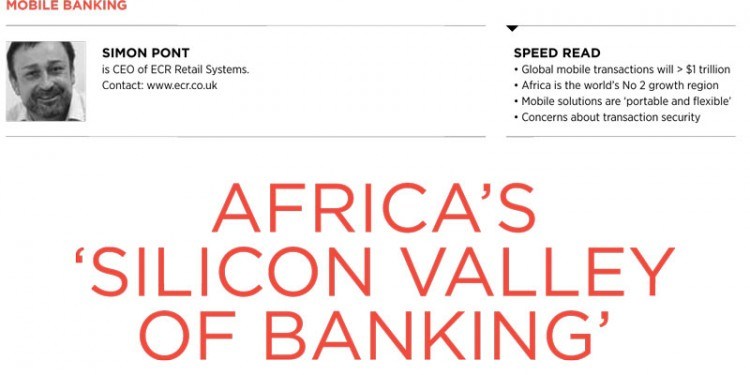“The future of banking is being defined in Africa,” enthuses one California-based mobile banking innovator. “It’s going to change the world.” SIMON PONT assesses the power of that continent’s doorstep banking revolution.
Significant investment in infrastructure and technology has accelerated growth in Africa over the past 15 years. That growth, partially boosted by a boom in mobile technology, has helped to establish the world’s second most populous continent as its second fastest growing economic region, expanding annually at a rate of 5.1%.
Consumers in the West may take advantage of the benefits of smartphones – largely their similarities to computers – but for Africans mobiles represent a whole way of life. Many don’t have access to a computer, so their mobile phone is the device that enables them to carry out all the essential tasks Western consumers have long taken for granted.
In 1998, there were less than 4m mobile phones on the continent; by 2011 that had swollen to 500m – half the population. By the end of last year that figure had risen to 735m. In fact, Africa is now the second largest mobile market by connections after Asia, and the world’s fastest growing mobile market.
Africa’s banking evolution began six years ago with the launch of Safaricom’s M-Pesa, a service which allows users to store money on their mobile, and then use it to pay their utility bill or send money via text. At the time, it was revolutionary – a cheap, easy-to-use service through which millions of Africans could access their bank account via their mobile without the hefty charges or the need to go into the bank itself.
Since then, technological changes have accelerated across Africa, altering the way banks think about the services they offer their customers, both in-branch and through mobile. In March 2009, MTN Uganda launched its own banking solution MobileMoney. One year later it boasted 600,000 users. Today, located across the country in distinctive canary-yellow buildings and kiosks, MobileMoney attracts 1.6m users and reaches 85% of the population.
As mobile technology advances, the capabilities and potential of mobile banking solutions become more complex. Beyond one-off electronic payments, what about mobile phone deposits and business banking? Are there alternatives, and how do you evaluate them? Is there enough spectrum to accommodate the increasing demand network demand for more connected devices?
In fact, it’s not all about technological innovation. Investment in technology is important but it’s providing a reliable and secure service which helps secure a high customer retention rate. And that involves much more than the device alone.
So what’s the next step for Africa’s rapidly evolving banking sector? Can it continue to develop and define the future of mobile banking? Is there a danger of growth slowing or too many technologies over-complicating the market?
California-based mobile-banking innovator Carol Realini, executive chairman Obopay, is enthusiastically optimistic: “Africa is the Silicon Valley of banking. The future of banking is being defined here… It’s going to change the world.” In fact it’s estimated that by 2015 global mobile transactions will exceed $1 trillion dollars. That may seem like a bold prediction but when you look at the growth trajectory it’s hard to argue.
While we know mobile technology is playing an essential part in Africa’s growth, its banking evolution is multi-faceted. There’s a variety of technologies circulating, each providing precise services and levels of connectivity and functionality.
Mobile banking doesn’t have to be limited to mobile phones. Nor is it restricted to simply sending money via SMS or a solution which processes transactions over the mobile network. It can take many forms, from contactless solutions to mobile payment terminals. People often have preconceived notions about the size and capabilities of mobile terminals. But, in many respects, they offer far more options than phones – for one, there’s no need to bolt on additional bulky accessories; they’re typically all-in-one devices.
That’s not to say mobile phones are an inferior product for banking, just that they only offer a specific type of service. The onus is on self-service and there are obviously concerns about security and the legitimacy of transactions. There is no way of getting an authorised slip from the bank confirming your deposit or withdrawal has been authorised and processed successfully from a mobile phone.
The future of banking in Africa will depend on how the major banks and their customers respond and embrace these new technologies. However, perhaps the biggest consideration is how the impact of mass mobile penetration is managed by the banks themselves, and how they use it to deliver effective withdrawal and deposit banking solutions. If handled correctly all of this will further empower customers while at the same time support the back-end office functions within bank branches.
At ECR Retail Systems, we’ve been operating in Ghana since 2011. We focus on delivering solutions which put the emphasis on customer needs and the services required to meet them, as well as helping businesses fulfil their potential by providing them with optimum transparency and traceability in relation to their finances.
I believe the next step in Africa’s banking evolution will stem from the development of a concept that I like to refer to as ‘High-Street Banking on your Doorstep’. We all know mobile solutions are portable, flexible and allow for a greater level of service to be delivered to customers, but those solutions have to fulfil very specific needs and requirements in order to be considered a success.
Africa’s lack of physical infrastructure and low level of internet penetration makes doorstep banking the perfect solution for utilising assets. In places with high cell phone penetration rates, there’s no need for any other service. But I’d like to see more of a balance. Africa doesn’t need to catch up by increasing its banking footfall in physical form but it does need to continue to invest in technology, particularly solutions which will benefit customers and the business operations of the banks themselves.

